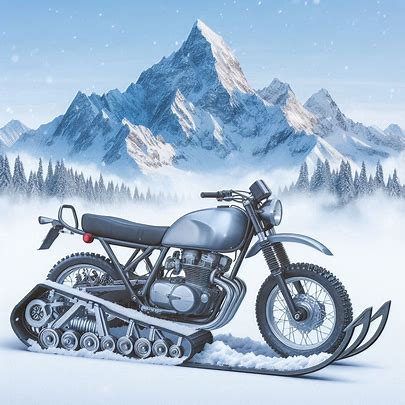 Snow biking offers an incredible way to experience the mountains, combining the thrill of dirt biking with the beauty of snowy landscapes. Staying fueled for a full day of snow biking, especially on a Timbersled, is crucial for both safety and enjoyment. With cold temperatures and high physical demands, riders must focus on the right nutrition and hydration to keep their energy up throughout the day.
Snow biking offers an incredible way to experience the mountains, combining the thrill of dirt biking with the beauty of snowy landscapes. Staying fueled for a full day of snow biking, especially on a Timbersled, is crucial for both safety and enjoyment. With cold temperatures and high physical demands, riders must focus on the right nutrition and hydration to keep their energy up throughout the day.
When preparing for your ride, consider the right fuel for your body just as you would for your machine. And for those looking to get into this exciting sport, you’ll find Timbersleds for sale in USA through specialized dealers.
Why Nutrition is Key for Snow Biking
Snow biking in winter conditions can be more physically demanding than other outdoor activities. The body needs more energy to stay warm and push through snowy terrain, so it’s essential to maintain a balanced intake of nutrients.
Factors to Consider:
- Cold Weather: Your body burns more calories to stay warm.
- High Intensity: Snow biking involves handling the bike, navigating rugged terrain, and constant balance.
- Long Rides: A full day on a Timbersled requires sustained energy, so planning your meals and snacks ahead is essential.
Essential Nutrients for Snow Biking
To maintain energy and performance, snowbikers should focus on a mix of carbohydrates, proteins, and fats. Each of these macronutrients plays a specific role in sustaining endurance, boosting strength, and keeping you focused.
1. Carbohydrates
Carbs are the body’s primary fuel source. Choose complex carbs to keep your energy levels stable. Avoid sugary snacks that cause spikes and crashes.
- Examples: Whole grain bread, oatmeal, brown rice, fruits
- Quick Tips: Pack dried fruits or energy bars made from oats and nuts to snack on throughout the day.
2. Protein
Protein helps repair and build muscles, which is particularly important after a demanding ride. Include some protein-rich snacks in your bag.
- Examples: Hard-boiled eggs, jerky, nut butter
- Quick Tips: Bring a protein bar or snack with nut butter for easy mid-day fueling.
3. Healthy Fats
Fats provide long-lasting energy and help maintain body warmth, which is crucial when riding in snowy conditions.
- Examples: Nuts, seeds, avocados
- Quick Tips: Mixed nuts are a great option; they’re lightweight, nutritious, and easy to snack on.
Hydration in Cold Weather
Cold weather can trick the body into feeling less thirsty, but dehydration is a real risk while snow biking. Staying hydrated keeps your muscles functioning and helps avoid fatigue. Drink plenty of water before heading out, and pack an insulated water bottle to keep your drink from freezing.
Hydration Tips:
- Start Hydrated: Before riding, begin your day with a full glass of water.
- Warm Beverages: Warm tea or a sports drink can help keep you hydrated and energized.
- Avoid Caffeine: Too much caffeine can lead to dehydration; limit coffee or energy drinks.
Planning Your Food for a Day on a Timbersled
Being prepared with the right foods can make all the difference. Aim for a nutritious breakfast, pack snacks, and plan for a lunch that’s easy to eat on the trail.
Breakfast: Fuel Up Before You Ride
Start the day with a balanced breakfast with protein, complex carbs, and healthy fats.
- Options: Oatmeal with nuts and fruit, eggs with whole-grain toast, or a smoothie with spinach, fruit, and a spoonful of protein powder.
- Benefits: This meal will provide the energy to get through the early part of your ride without feeling sluggish.
Snacks: Keep Energy Steady Throughout the Day
Choose snacks that are easy to eat and packed with nutrients. Small snacks throughout the day will help keep your energy and focus up.
- Examples: Trail mix with nuts and dried fruit, energy bars, banana
- Benefits: A snack every few hours will help you avoid energy crashes.
Lunch: A Mid-Day Boost
A packed lunch can be as simple as a sandwich with lean protein or a wrap filled with vegetables, cheese, and a bit of avocado.
- Options: Whole-grain sandwich with turkey or hummus, wrap with spinach and chicken, or a quinoa salad with veggies.
- Benefits: These meals are easy to digest and energize you for the afternoon session.
Tips for Eating Right on the Trail
Snow biking calls for practical food choices that don’t require a lot of prep or cleanup. Here are a few tips to make fueling up on the trail easy:
- Pre-Pack Meals: Prepare food in resealable bags or easily open containers.
- Layer Foods: Keep snacks like granola bars in an inside pocket to prevent them from freezing.
- Choose Compact Foods: Space is limited, so opt for calorie-dense options that don’t take up too much room.
Post-Ride Nutrition
Once the day is over, focus on recovery. Eating the right foods post-ride can help your muscles recover and keep you feeling strong for the next adventure.
- Protein and Carbs: These are essential after a day on the trails. A smoothie with protein powder, banana, and almond milk or a simple chicken and veggie stir-fry can be ideal.
- Rehydrate: Drink plenty of water, and consider a beverage with electrolytes if you feel depleted.
READ ALSO: Karaoke Cuisine: The Perfect Pairings for Singing in Gangnam
Wrapping Up
Nutrition is vital in snow biking, especially when the weather and terrain are challenging. Prioritizing a balanced diet, staying hydrated, and preparing the right foods can make your snow biking day on a Timbersled a fantastic experience. Take time to plan meals and snacks, and you’ll have the energy to confidently tackle the slopes.
